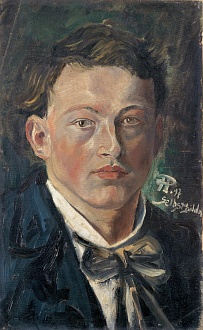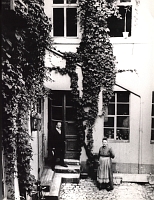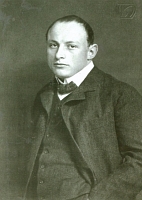Speyer/ Munich 1880-1904
1880
Hans Marsilius Purrmann is born on April 10, 1880 in Speyer, Kleine Greifengasse 14, as the first son of the painter Georg Heinrich Purrmann (1846–1900) and his wife Elisabeth, née Schirmer (1848–1916). He has a younger brother, Heinrich Christian (1881–1943), who married Elisabeth von Walck, and a younger sister, Friederike (1884–1963), who married the postal inspector Otto Albig in 1913. Purrmann remained steadily in contact with both his siblings throughout their lives; large parts of their correspondence are extant.
1886-1893
Purrmann’s school years are brief; he attends primary school in Speyer, followed by one year of secondary school there. “In knowledge and school training, I could have been outdone by any maid. Only with difficulty, as a “weak”... pupil, did I make it through part of primary school and a single year of secondary school.” (Purrmann 1951, in Göpel 1961, p. 11)
1893-1895
Purrmann learns the trade of decorative painting from his father. On the side, he pursues artistic interests of his own, as can be seen in the small townscapes and a larger landscape painted in the environs of Speyer.
1895-1897
Interior decorator in his father's business
1897
Purrmann registers as a resident with the Munich police on October 24. He begins his studies at the Academy of Visual Arts in Munich in the winter semester of that year. Purrmann first studies drawing under Gabriel von Hackl, then painting with Franz von Stuck. Among his fellow students are Paul Klee, Wassily Kandinsky, Albert Weisgerber, Eugen von Kahler, and Willi Geiger.
1899
Purrmann’s father’s poor health prevents him from going to Munich in 1899.
1900
Purrmann’s father Georg dies on July 5. His brother Heinrich takes over the family business, providing Purrmann with the opportunity to become an independent artist
1902/03
Purrmann receives the Henry Hilgard Grant for the Advancement of Visual Artists in the Palatinate in both these years (Jöckle 2001, p. 268).
1903/04
With von Stuck’s support, Purrmann is able to participate in the 1903 and 1904 spring exhibitions of the Munich Secession, receiving well-meaning reviews from Wilhelm Wittmann and Hans Rosenhagen.
According to Karl Scheffler, the art historian Karl Voll who taught in Munich, discovers Purrmann in this period. Voll’s pupils Friedrich Rintelen and Heinz Braune also soon make Purrmann’s acquaintance.
According to Karl Scheffler, the art historian Karl Voll who taught in Munich, discovers Purrmann in this period. Voll’s pupils Friedrich Rintelen and Heinz Braune also soon make Purrmann’s acquaintance.
Svinar 1903/04
Purrmann is twice a guest during the summer months in Svinar, near Prague, at the family residence of Eugen von Kahler (1882–1911). Purrmann makes a number of paintings of parks and gardens, and a photo shows the two artists in 1903 in front of one of Purrmann’s paintings.








